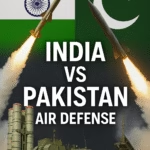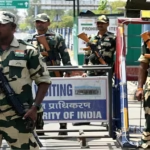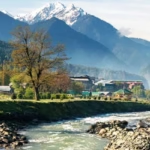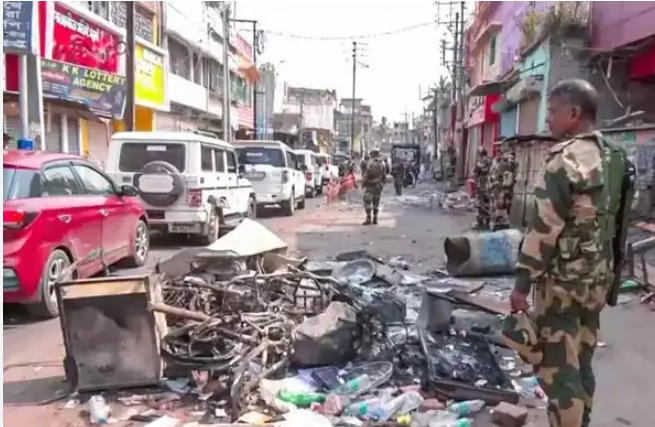On April 22, 2025, the serene meadows of Pahalgam in Jammu and Kashmir turned into a scene of horror when terrorists opened fire on tourists visiting the picturesque Baisaran Valley. This ruthless attack resulted in the death of at least one tourist and injuries to several others, sending shockwaves across the nation. The incident has not only left the immediate victims traumatized but has also cast a long shadow over Kashmir’s tourism industry, which had been showing promising signs of revival. This comprehensive report examines the Pahalgam terror attack from multiple angles—tracing what happened, analyzing the immediate responses, exploring the broader implications, and reflecting on the path forward for this beloved tourist destination.
Introduction to Pahalgam and Its Importance
Known poetically as “The Valley of Shepherds,” Pahalgam stands as one of Kashmir’s crown jewels. Situated at the confluence of streams flowing from Sheshnag Lake and the Lidder River, this hill station sits at an altitude of 2,130 meters, approximately 95 kilometers from Srinagar in the Anantnag district of Jammu and Kashmir6. What was once a humble shepherd’s village has transformed into Kashmir’s premier resort destination, drawing visitors from across India and beyond.
Pahalgam’s allure lies in its breathtaking natural beauty—lush green meadows that stretch toward the horizon, dense pine forests that whisper with the mountain breeze, and the crystalline Lidder River that carves its way through the landscape. The region remains pleasantly cool even during peak summer months, with temperatures rarely exceeding 25°C. This climate has made it a favored retreat for those seeking respite from the scorching heat that blankets much of India during summer.
The town holds particular significance as the traditional starting point for the annual Amarnath Yatra, a pilgrimage of immense religious importance for Hindus. Each year, thousands of devotees pass through Pahalgam on their journey to the holy cave shrine of Amarnath, believed to be the abode of Lord Shiva6. The 2025 pilgrimage was scheduled to commence on July 3, adding another layer of concern to the timing of this attack.
The Baisaran Meadow: A Paradise Turned Battleground
Among Pahalgam’s many attractions, the Baisaran meadow holds a special place. Often referred to as “mini Switzerland” for its picturesque landscapes, this verdant expanse sits about 5 kilometers from the main town. Accessible only by foot or horseback, Baisaran offers visitors spectacular panoramic views of Pahalgam and the Lidder Valley. The meadow is encircled by dense pine forests and snow-capped mountains, creating a postcard-perfect setting that has drawn countless tourists and even Bollywood film crews over the decades.
Prior to the attack, Baisaran was known as a place of tranquility and natural splendor—a location where families would picnic, couples would seek romantic solitude, and photographers would capture the raw beauty of Kashmir. The meadow also served as a camping site for trekkers heading toward Tulian Lake, embodying the adventurous spirit that Pahalgam nurtures. Now, tragically, it will also be remembered as the site of a horrific attack that shattered the peace of this mountain paradise.
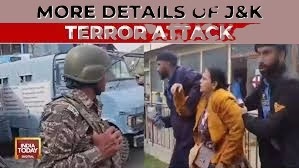
What Happened During the Pahalgam Terror Attack?
On the afternoon of April 22, 2025, what began as another beautiful spring day in Pahalgam quickly descended into chaos and horror. At approximately 2:30 PM, unidentified terrorists emerged from the dense pine forests surrounding the Baisaran meadow and opened fire on a group of Indian tourists enjoying the scenery. The attack was as sudden as it was brutal, with gunmen reportedly firing indiscriminately at visitors who had no means of protection or escape in the open meadow.
According to eyewitness accounts, the attackers may have been wearing camouflage, allowing them to blend into the surrounding forest before launching their assault. The sound of gunfire echoed across the valley, replacing the usual chorus of birdsong and tourist chatter with screams and panic. What should have been a highlight of these visitors’ Kashmir experience became instead a nightmare they would never forget.
The remote location of Baisaran complicated both escape and rescue efforts. With no road access to the meadow, injured tourists could not be quickly evacuated by conventional ambulances. Instead, local residents played a crucial role in the immediate aftermath, helping to evacuate the wounded using ponies—the traditional mode of transport to and from the meadow. Their swift action undoubtedly saved lives as the minutes ticked by and the injured awaited medical attention.
Timeline of Events: A Minute-by-Minute Breakdown
2:30 PM: Terrorists emerge from the forests surrounding Baisaran meadow and open fire on tourists.
2:35 PM: Initial panic ensues as tourists scramble for cover. Some are hit immediately, while others attempt to hide behind whatever sparse protection the open meadow offers.
2:40 PM: The first calls for help reach Pahalgam. Local guides and pony wallahs in the area become aware of the attack.
2:45 PM: The news reaches security forces. First responders begin mobilizing, while locals already at Baisaran start to help the injured.
3:00 PM: Local residents, showing remarkable courage, begin evacuating wounded tourists using ponies to transport them down the 5-kilometer trail to Pahalgam.
3:15 PM: Security forces including military, CRPF, and local police reach the outskirts of Baisaran and begin moving toward the attack site.
3:30 PM: Medical teams at Pahalgam hospital prepare to receive casualties as the first injured tourists arrive from the meadow.
3:45 PM: Security forces establish a perimeter around Baisaran and launch a comprehensive search operation, deploying personnel in all directions to locate the perpetrators.
4:00 PM: Authorities deploy a helicopter to assist with evacuating the more seriously wounded victims.
4:30 PM: News of the attack reaches Srinagar and Delhi. Union Home Minister Amit Shah is briefed about the incident1.
5:00 PM: The Resistance Front (TRF), a shadow outfit of the Pakistan-based terrorist group Lashkar-e-Taiba, claims responsibility for the attack.
5:30 PM: Home Minister Amit Shah briefs Prime Minister Narendra Modi about the attack. Plans are made for the Home Minister to visit Srinagar for an urgent security review meeting.
6:00 PM: The injured are stabilized at local medical facilities. The more critically wounded are prepared for transfer to advanced care centers.
Evening: Security operations continue into the night as forces attempt to track down the perpetrators who may have fled into the surrounding mountains.
Who Were the Victims and Eyewitness Accounts
The attack claimed at least one life—Manjunath, a tourist from Karnataka’s Shivamogga district. His death represents not just a statistic but a life cut short, a family shattered, and dreams unfulfilled. Beyond this confirmed fatality, reports indicated that between 7 and 20 others sustained injuries of varying severity.
The victims were primarily domestic tourists who had traveled to Kashmir to experience its legendary beauty—individuals and families who had saved for their vacations, planned their itineraries, and looked forward to creating memories in one of India’s most spectacular landscapes. Instead, they became unwitting participants in a tragedy that would forever alter their lives.
Eyewitness accounts paint a harrowing picture of the attack and its aftermath. One survivor, whose name has been withheld, shared her traumatic experience: “My husband was shot in the head while seven others were also injured in the attack,” she told reporters over a phone call. Her words, stark in their simplicity, convey the brutal reality of what transpired on that meadow.
Videos circulating online showed the chaotic aftermath—security forces and police rushing to the scene, injured tourists lying on the ground, and distressed women crying as they searched desperately for their loved ones. These raw, unfiltered moments captured the human toll of the attack in ways that statistics cannot.
Local residents who assisted with the rescue efforts described scenes of panic and heroism. Despite the risk that the attackers might still be in the vicinity, these civilians rushed to help the wounded, using ponies to transport them down the mountain to waiting medical teams. Their actions speak to the fundamentally compassionate nature of Kashmiris, who, despite decades of conflict in their homeland, still respond to human suffering with empathy and courage.
Reactions from Locals, Officials, and International Community
The Pahalgam terror attack triggered a wave of condemnation from across the political spectrum and society at large. From the highest offices in Delhi to the streets of Srinagar, voices united in denouncing the violence and expressing solidarity with the victims.
Chief Minister Omar Abdullah was among the first officials to respond, expressing profound shock at the attack. “I’m shocked beyond belief. This attack on our visitors is an abomination. The perpetrators of this attack are animals, inhuman and worthy of contempt. No words of condemnation are enough. I send my sympathies to the families of the deceased,” he stated on social media. The Chief Minister’s words reflected not just official condemnation but genuine horror at an act that targeted innocent tourists.
Lieutenant Governor Manoj Sinha also strongly condemned the attack, promising accountability: “I strongly condemn the cowardly terror attack on tourists in Pahalgam. I assure the people that those behind this despicable attack will not go unpunished,” he posted on X (formerly Twitter). His assurance spoke to the government’s determination to bring the perpetrators to justice.
At the national level, Prime Minister Narendra Modi was briefed about the situation by Home Minister Amit Shah. The Prime Minister reportedly asked the Home Minister “to take all suitable measures” and directed him to visit the site. This high-level involvement underscored the seriousness with which the central government viewed the attack.
Former Jammu and Kashmir Chief Minister Mehbooba Mufti denounced the violence, highlighting the region’s tradition of hospitality towards tourists and calling for a thorough investigation3. Her statement reflected the sentiment of many Kashmiris who take pride in their reputation for hospitality and feel deeply ashamed when visitors become targets of violence.
Local residents in Pahalgam expressed a mixture of horror, sorrow, and concern for the future. Many who depend on tourism for their livelihoods worried about the long-term implications of such an attack. “We treat tourists like our own family. This attack is not just on them but on our way of life,” said one local hotelier who requested anonymity. “Kashmir has seen enough bloodshed. We want peace and prosperity, not more violence.”
The international community also took note of the attack, with several countries issuing statements condemning terrorism and expressing sympathy for the victims. Travel advisories for Kashmir were promptly updated by several nations, potentially complicating the region’s efforts to rebuild its tourism sector.
Analysis: Why Was Pahalgam Targeted?
The targeting of Pahalgam, particularly the Baisaran meadow, appears to have been a calculated decision rather than a random act of violence. Several factors may have influenced the terrorists’ choice of target and timing.
First, attacking tourists represents a strike at Kashmir’s economic lifeline. Tourism constitutes a significant portion of the region’s economy, providing livelihoods for thousands of locals who work as hoteliers, restaurateurs, taxi drivers, guides, and handicraft sellers. By creating fear among potential visitors, terrorists can strangle the economic recovery of the region and increase local discontent.
Second, the timing—just over two months before the scheduled commencement of the Amarnath Yatra on July 3—suggests a possible attempt to disrupt preparations for this major pilgrimage. The Yatra brings thousands of devotees to Kashmir and requires extensive security arrangements. An attack near one of the main routes could be interpreted as a warning or an attempt to strain security resources.
Third, Pahalgam’s profile as a “crown jewel” of Kashmir tourism makes it a high-visibility target. An attack here generates maximum media attention and creates widespread fear, extending the psychological impact far beyond the immediate victims.
The Resistance Front (TRF), which claimed responsibility for the attack, has been described as a shadow outfit of the Pakistan-based terror group Lashkar-e-Taiba. The group has been active in Kashmir in recent years, often targeting civilians and security forces. Their involvement suggests a continued effort by cross-border terror organizations to destabilize Kashmir and disrupt India’s efforts to normalize the situation in the region.
Historically, Kashmir has experienced similar attacks on tourists, though they have been relatively rare in recent years. In April 2006, for instance, eight tourists were among 20 people injured in a grenade explosion at the crowded bus stand of Pahalgam. That attack, nearly two decades earlier, shows the persistent nature of the threat, even as Kashmir has gone through periods of relative calm and acute violence.
Implications for Kashmir Tourism and Local Economy
The Pahalgam terror attack struck at the heart of Kashmir’s economic recovery efforts. Tourism in the valley had been showing promising signs of revival, with 2025 expected to be a banner year for visitor numbers. The attack threatens to unravel this progress, with immediate and potentially long-lasting consequences.
In the immediate aftermath, Pahalgam witnessed a mass exodus of tourists. The once-bustling resort town became eerily quiet as visitors evacuated, concerned for their safety. Hotel cancellations surged not just in Pahalgam but across Kashmir as travelers reassessed the risks of visiting the region.
For local businesses dependent on the summer tourist season—which typically peaks from April through June—this sudden departure of visitors represents a devastating financial blow. From luxury houseboat owners in Dal Lake to humble pony wallahs in Pahalgam, countless Kashmiris saw their seasonal income prospects vanish overnight.
“We wait all year for these three months,” lamented Mohammad Yusuf, a fictional shopkeeper in Pahalgam’s main market. “Our entire family depends on what we earn during the tourist season. What will we do now?” His concern echoes that of thousands of others whose livelihoods hang in the balance.
Beyond the immediate economic impact lies a more complex challenge: rebuilding Kashmir’s image as a safe destination. Tourism depends heavily on perception, and a single violent incident can overshadow years of peaceful visits by millions of tourists. Travel advisories, media coverage, and word-of-mouth all shape potential visitors’ decisions, and all were negatively affected by the attack.
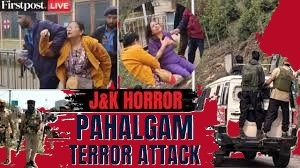
The timing is particularly cruel, coming as it does at the beginning of the peak tourist season and ahead of the Amarnath Yatra. Many businesses invest heavily in preparation for these crucial months, taking loans to renovate accommodations, purchase inventory, or hire additional staff. With tourists departing and future bookings canceled, these investments may not yield returns, potentially leading to a wave of business failures and increased unemployment.
Moreover, the attack may disproportionately harm small, local businesses that lack the financial reserves to weather a prolonged downturn. Larger hotel chains and tour operators with diverse portfolios can redirect customers to other destinations, but a Kashmiri family that owns a single guesthouse in Pahalgam has no such option.
How Authorities Responded After the Attack
The response to the Pahalgam terror attack involved multiple agencies working in coordination to treat the injured, secure the area, and begin the process of tracking down the perpetrators.
The immediate priority was medical care for the victims. Local healthcare facilities in Pahalgam received the injured, with doctors and nurses working tirelessly to stabilize those with gunshot wounds and other trauma. Medical teams were dispatched promptly, and authorities deployed a helicopter to assist with evacuating the more seriously wounded.
Simultaneously, security forces including the military, Central Reserve Police Force (CRPF), and local police swarmed the Baisaran area. They established a perimeter and initiated a comprehensive search operation, deploying personnel in all directions to locate the attackers who had melted into the surrounding forests12. The challenging terrain—dense woods and mountainous landscape—complicated these efforts, providing numerous potential hiding places for the terrorists.
At the highest levels of government, the attack triggered immediate action. Union Home Minister Amit Shah held a meeting with concerned officials through video conferencing to assess the situation1. He briefed Prime Minister Narendra Modi, who in turn asked the Home Minister to take all suitable measures and directed him to visit the site personally. This high-level involvement underscored the seriousness with which the government viewed the attack.
In his statement, Home Minister Shah expressed anguish at the attack and asserted that “those involved in this dastardly act of terror will not be spared.” He promised that the government would “come down heavily on the perpetrators with the harshest consequences” and expressed condolences to the families of the deceased1.
Local administration in Jammu and Kashmir also mobilized rapidly. Districts across the valley saw increased security presence, with additional checkpoints established on major roads and heightened vigilance at tourist spots. The attack prompted a review of security arrangements for the upcoming Amarnath Yatra, with officials likely to recommend enhanced measures along the pilgrimage routes.
Measures Taken to Strengthen Security Post-Attack
In the wake of the Pahalgam terror attack, authorities implemented a series of security enhancements aimed at preventing similar incidents and restoring public confidence. These measures reflected the government’s determination to protect tourists and local residents alike while sending a strong message to terrorist organizations.
The most visible change was the increased deployment of security personnel at tourist destinations throughout the Kashmir Valley. Popular sites like Gulmarg, Sonamarg, and Dal Lake saw a surge in uniformed presence, with regular patrols and strategically positioned checkpoints. In Pahalgam itself, security forces established a permanent presence at access points to major attractions, including the path to Baisaran meadow.
Intelligence gathering and sharing received renewed emphasis, with agencies directed to improve coordination and act preemptively on threat information. This included increased surveillance of known sympathizers of terrorist organizations and more rigorous monitoring of social media for signs of radicalization or attack planning.
For tourists specifically, authorities introduced new safety protocols. These included mandatory registration of visitors at designated checkpoints, provision of emergency contact numbers, and establishment of tourist police booths at major destinations. Some areas implemented buddy systems where local guides would accompany tourist groups, serving both as cultural interpreters and security liaisons.
The transportation infrastructure also saw enhanced security, with increased checking of vehicles entering tourist areas and deployment of road opening parties (ROPs) to secure routes commonly used by visitors. Hotels and guesthouses were instructed to heighten their own security measures, including verification of guests’ identities and installation of additional surveillance cameras.
Looking ahead to the Amarnath Yatra, scheduled to begin on July 3, authorities announced a comprehensive security review. The pilgrimage, which attracts thousands of devotees who travel via two routes—the traditional 48-km Pahalgam path in Anantnag district and the shorter but steeper 14-km Baltal route in Ganderbal district—would likely see unprecedented security arrangements in 2025.
These measures, while necessary, created their own challenges. The heavy security presence, while reassuring to some, risked detracting from the natural beauty and peaceful atmosphere that draw visitors to Kashmir in the first place. Authorities faced the delicate task of balancing safety concerns with the desire to preserve Kashmir’s appeal as a tourist destination.
Long-Term Impact on Pahalgam and Its People
Beyond the immediate aftermath lies the question of long-term impact—how the Pahalgam terror attack will shape the future of this beloved destination and the lives of those who call it home. The ripple effects will likely be felt for years to come, touching everything from the local economy to community relationships and the psychological well-being of residents.
For Pahalgam’s people, the attack represents not just a security incident but a profound violation of their way of life. Many locals take immense pride in their tradition of hospitality, viewing tourists not merely as sources of income but as honored guests. The targeting of these guests strikes at the heart of Kashmiri identity and values.
“We have always welcomed visitors with open arms,” reflected Abdul Rashid, a fictional elderly resident who has witnessed decades of Kashmir’s tumultuous history. “Even in the darkest days of conflict, we never lost our capacity to be kind to strangers. This attack feels like an assault on that fundamental part of who we are.”
Economically, recovery will depend largely on how quickly and effectively security concerns can be addressed. If tourists perceive Pahalgam as dangerous for an extended period, the structural damage to the local economy could be severe. Businesses may close, skilled workers might migrate to more stable regions, and the intricate economic ecosystem that has developed around tourism could unravel.
The psychological impact on residents should not be underestimated. Communities that experience violence often suffer from collective trauma, with increased rates of anxiety, depression, and post-traumatic stress. Children are particularly vulnerable to these effects, potentially carrying the emotional scars of such events into adulthood.
Intercommunity relations in the broader Kashmir region may also face strain. Terror attacks can exacerbate existing tensions and fuel suspicion between different religious or ethnic groups. Local leaders and civil society organizations will need to work proactively to counter such divisive tendencies and reinforce the valley’s tradition of communal harmony.
Yet amid these challenges, Kashmir has repeatedly demonstrated remarkable resilience. Through decades of conflict, natural disasters, and political upheaval, its people have maintained their dignity, creativity, and hope for a better future. This capacity for resilience suggests that Pahalgam, too, will eventually recover from this trauma.
Indeed, history shows that tourist destinations targeted by terrorism can and do recover, though the path is rarely quick or easy. From Bali to Barcelona, places that have experienced attacks have eventually reclaimed their status as beloved destinations. With appropriate support, Pahalgam may follow a similar trajectory.
Final Thoughts: Moving Forward from Tragedy
As the dust settles on this tragic event, the people of Pahalgam and Kashmir face the difficult task of moving forward. The path ahead is neither straight nor clear, but certain principles can guide the journey toward healing and renewal.
First, there must be justice. The perpetrators of this attack must be identified and held accountable through proper legal channels. Justice serves not only as a deterrent to future violence but as an essential step in the healing process for victims and the broader community.
Second, security improvements must be balanced with preserving the essential character of Pahalgam. Heavy-handed measures that transform the town into a militarized zone may prevent attacks but could also destroy the very qualities that make it special. The challenge lies in finding approaches that enhance safety without sacrificing the natural beauty and peaceful atmosphere that draw visitors to the region.
Third, economic support for those affected is crucial. This includes not just the direct victims of the attack but also the many businesses and individuals whose livelihoods have been disrupted. Government assistance, low-interest loans, and targeted investments can help bridge the gap until tourism recovers.
Fourth, the narrative around Kashmir must not be allowed to revert solely to one of conflict and danger. The attack represents a deviation from—not a definition of—Kashmir’s reality. Continued promotion of the region’s cultural richness, natural beauty, and hospitable people remains essential, even as security concerns are addressed.
Fifth, the resilience and humanity of Kashmir’s people deserve recognition and support. Time and again, Kashmiris have demonstrated their capacity to maintain dignity and compassion even under the most challenging circumstances. Their refusal to surrender to hatred or despair represents perhaps the most powerful repudiation of terrorism’s destructive ideology.
The story of Pahalgam did not begin with this attack, nor will it end here. For centuries, this valley has witnessed the ebb and flow of human joy and sorrow against the unchanging backdrop of its magnificent mountains. Long after the headlines fade and the immediate crisis passes, Pahalgam will continue its evolution—shaped by this tragedy but not defined by it.
In the words attributed to an ancient Kashmiri saying: “When winter comes, can spring be far behind?” Even in this moment of darkness, the seeds of renewal are already present. The same resilience that has carried Kashmir through countless challenges will once again prove stronger than the forces that seek to destroy it.
For visitors who love Kashmir, perhaps the most meaningful response is not to stay away but to return when conditions allow—to walk once more in the meadows of Baisaran, to enjoy the hospitality of Pahalgam’s people, and to demonstrate through their presence that terrorism cannot erase the fundamental appeal of this extraordinary place.
In this way, the legacy of the Pahalgam terror attack may ultimately be not one of fear and division, but of renewed appreciation for the precious gift that Kashmir represents to India and the world.


